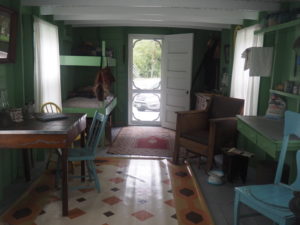
Marietta is the first completely planned community in the Northwest Territory of the United States. It has been home to many groups, such as Native Americans and revolutionary heroes, early European immigrants and Japanese workers who are employed there today. That has made Marietta a cultural and historical melting pot (with some impressive engineering thrown into the mix). The best way to get a glimpse of all the treasures the city has to offer is to hop on a trolley tour. Within an hour and a half, tour guide Harley Noland shares 3,000 years of historical knowledge, some of the titbits are even new to the locals. Below are the most exciting stops in Marietta.
East Muskingum Commons

The first stop on the tour is East Muskingum Commons, a ceremonial spot where the pioneers first entered Marietta. In a clear field of grass, there is a towering sculpture of three men in cloaks with their hands on their hilts and their feet inside a boat. “It is the most important piece of public sculpture in Marietta,” Noland says. The spot honors the pioneers who settled in Marietta. The piece was made by Gutzon Borglum, who then went on to carve Mount Rushmore. Behind the monument are flags of the states that were divided from the mass of land that was the Northwest Territory.
Next stop on the tour is the Ohio River Museum, close to the Washington Street bridge. The destination houses the history of three different styles of boats that were once operated on the Ohio River—shanties used by people who traveled from one city to another looking for jobs, wooden flatboats like the ones used by the pioneers, and imposing ships used for trading and transport. The most impressive of the objects is an enormous ship, two stories tall and bobbing up and down to the gentle movement of the river. “This is the single-largest artifact owned by the Ohio River Museum,” Noland says. “[It’s] the last coal-fired, steam-powered, stern-wheeled boat to have operated on this river.” Despite its size, it can float in just 4 feet of water—a marvelous achievement in engineering.
Mound Cemetery
The last stop on the tour is the Mound Cemetery, a spot marked with memories for natives and settlers of the region. Deep inside it is “Conus,” a steep mound that was a burial site. The pioneers were educated enough to know archeology (and clearly Latin) so they dug into it. But when they found human remains, they reburied them and prohibited any more excavation. “What’s amazing to me is that the pioneers respected these people that were buried here and buried their loved ones around them,” Noland says.
The Mound Cemetery isn’t just a popular tourist attraction due to its Native American heritage. Many revolutionary officers are also buried around the mound. There’s Rufus Puttnam, the founding father of Marietta. Abraham Whipple is buried there, too, the first commodore of the U.S. Navy and the first person known to have fired a shot at a British naval vessel during the Revolutionary War. There are officers from England, France, Germany, Spain, Italy and the island nations of Cuba and Jamaica buried here. “In this cemetery are more revolutionary officers than anywhere else in the United States,” Noland says.
Over the years, people from all around the world have found a piece of their home in the quaint city in the corner of Ohio. St. Paul’s Evangelical Church just opposite the Mound Cemetery even had service in German. That is until the World Wars started. Noland’s own heritage is mostly English, a little French, and he had one grandmother who was German. “I’m a mixture,” he says with a warm smile. Just like Marietta.
